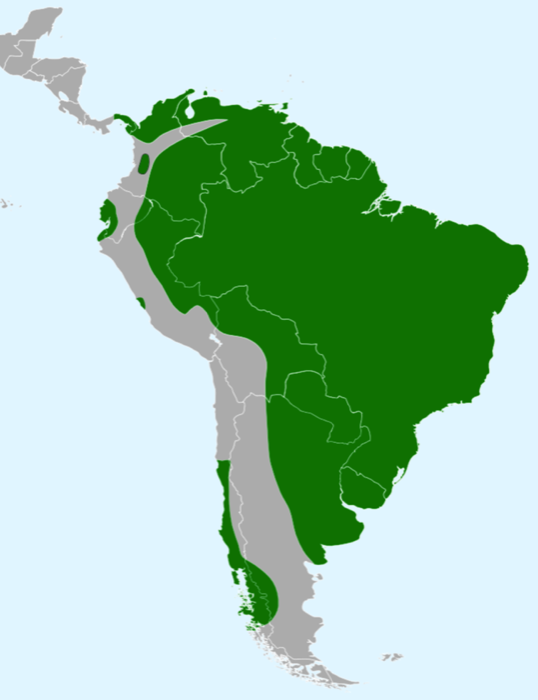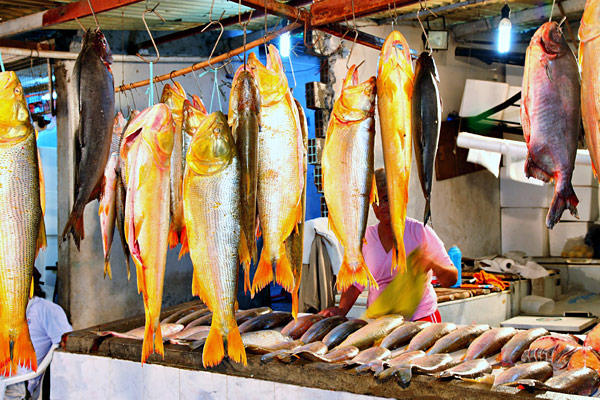Nightjar
Nightjar
Known locally as the Gavião-real (Royal Hawk), the Harpy Eagle is the largest raptor in the South American rainforest, and one of the world's largest eagles – albeit with a comparatively short wingspan which increases its manoeuvrability through forested habitats. Although rare, it ranges widely across Latin American rainforests where it inhabits the upper canopy and preys on small animals among the tree-tops.
Overview
Dorado (Salminus brasiliensis) can measure up to 1 metre (3.3 ft) in length. They're golden yellow in colour, with a regular pattern of black tonal scales forming a pattern of longitudinal black lines along the body. It has sometimes reddish fins, a black stripe on the tail, and an especially muscular jaw packed with two rows of saw-like teeth. The dorado has been described as "a prehistoric golden trout or salmon with the jaws of a pit bull terrier". As such, it's bony head and jaw muscles comprise around a quarter of its overall length. Also, as befitting a predator, it has well-developed eyesight and smell. Despite its scientific name and general shape, the dorado isn't related to the salmon - it's freshwater fish without any ocean-going phase.
There is little visual differentiation between the males/females - except some minor physical differences on the anal fin. The most obvious indication is likely to be the size as females grow to be considerably larger - reaching 30 kg. By contrast, the males grow only to around 10 kg.
There is little visual differentiation between the males/females - except some minor physical differences on the anal fin. The most obvious indication is likely to be the size as females grow to be considerably larger - reaching 30 kg. By contrast, the males grow only to around 10 kg.
Behaviour and Habitat
Based on it's mood, the dorado switches from being Dr Jekyll to Mr. Hyde. It can be mild and timid or it can be a savage predator. It sits at the top of the food chain - actively hunting other smaller fish. It's sharp teeth and powerful jaws make a quick meal of anything that gets in its way - with its jaws very occasionally turning on swimmers or fisherman exercising insufficient care with the fish they've just reeled in. Their favourite hunting grounds appear to be the rough water near waterfalls and rapids, or the entryways into lakes and streams. They also shelter under fallen trees or other underwater obstructions, using them as a station to hunt. The dorado's diet consists primarily of other fish - but analysis of stomach contents have also shown them to eat large inserts, small vertebrates (such as rodents), snakes, lizards and birds.
Dorado are migratory - moving up and down the regions' connected river systems as the seasons, temperature and food sources change. They occupy a range of freshwater environments stretching across southern Brazil, northern Argentina, Uruguay, and into Bolivia and Paraguay. This habitat includes the river basins of the Paraguai (and Pantanal), Uruguai, Chaparé, and Mamoré Rivers, plus the drainage area of the Lagoa dos Patos lagoon in the Brazilian state of Rio Grande do Sul. Close relatives of the dorado can also be found in the Rio São Francisco (Salminus franciscanus); the upper Paraná, Amazon and Orinoco basins (Salminus hilarii or tabarana); and in the Santiago and Magdalena basins of Ecuador and Colombia (Salminus affinis or Dorada/Rubia).
Dorado are migratory - moving up and down the regions' connected river systems as the seasons, temperature and food sources change. They occupy a range of freshwater environments stretching across southern Brazil, northern Argentina, Uruguay, and into Bolivia and Paraguay. This habitat includes the river basins of the Paraguai (and Pantanal), Uruguai, Chaparé, and Mamoré Rivers, plus the drainage area of the Lagoa dos Patos lagoon in the Brazilian state of Rio Grande do Sul. Close relatives of the dorado can also be found in the Rio São Francisco (Salminus franciscanus); the upper Paraná, Amazon and Orinoco basins (Salminus hilarii or tabarana); and in the Santiago and Magdalena basins of Ecuador and Colombia (Salminus affinis or Dorada/Rubia).
Reproduction
Dorados' behaviour is generally solitary, but changes in the reproductive period of late spring and summer (Oct-Mar). During this time, dorado will flock together are they migrate back towards their breeding grounds - sometimes jumping up small waterfalls and rapids. This period, known as the piracema (spawning) is crucially important for the protection of Pantanal fish stocks - coinciding with a total fishing ban. According to some literature, the migration journey is around 400 km, with a daily average distance travelled of around 15 km. Unfortunately, the construction of dams and other barriers can block off dourados' migration paths - which is why the maintenance of the Pantanal is so important, as its main waterway, the Paraguai river, is the last major river in the area to remain undammed.
Females reach maturity at around 4 or 5 years of age, and will start to take part in the annual spawning. Each female dorado can deposit up to 2 million eggs. The emergence of the young fish coincides with the period of peak food availability - making it a little easier dorado to survive. However, the eggs and young dorado are defenceless - meaning that they also make a good meal for other opportunistic predators (including other larger dorado). As a result, few young dorado ever reach maturity. Notably, immature dorado are silver in colour - making them easily confused with the closely-related Tabarana (Salminus hilarii). However, they yellow-gold tone gets strong as the dorado age. These are a slow-growth fish - with a lifespan exceeding 15 years. Sadly, increased environmental pressures and overfishing across much of its range mean that fewer fish are reaching this age - with both their size and numbers decreasing.
Females reach maturity at around 4 or 5 years of age, and will start to take part in the annual spawning. Each female dorado can deposit up to 2 million eggs. The emergence of the young fish coincides with the period of peak food availability - making it a little easier dorado to survive. However, the eggs and young dorado are defenceless - meaning that they also make a good meal for other opportunistic predators (including other larger dorado). As a result, few young dorado ever reach maturity. Notably, immature dorado are silver in colour - making them easily confused with the closely-related Tabarana (Salminus hilarii). However, they yellow-gold tone gets strong as the dorado age. These are a slow-growth fish - with a lifespan exceeding 15 years. Sadly, increased environmental pressures and overfishing across much of its range mean that fewer fish are reaching this age - with both their size and numbers decreasing.
Dorado and pacú photographed in an Argentine marketplace. Photo: Humberto Terenziani.
Sports Fishing
Dorado are among the most coveted trophies for South American anglers, sports fishermen and tourist. Besides its large size, beautiful appearance and taste, the fish has a well-earned reputation as a strong fighter with high jumps and stamina - requiring strength, skill and patience to catch successfully. Sports fishing doesn't necessarily present a conflict with conservation. The flow of tourists and economic benefit can help quantify the value of the fish - promoting measures for the preservation and management of fish stocks. The increased trend towards catch and release fishing also means that fish aren't necessarily being depleted or taken out of the breeding population.
Conservation and Threats
Some areas, where they were formerly abundant, dorado are now rarely encountered. Dorado also now appears on the threatened species list for the Brazilian state of Rio Grande do Sul due to the intense degradation and pollution of natural habitat, combined with pressures from overfishing. In many areas of its range, the ability for dorado to follow their natural migratory routes has been negatively impacted by the construction of hydroelectric dams and other barriers, as well as pollution from manufacturing and agricultural run-offs. Although its possible to construct dams with fish ladders, fish elevators and other technologies to help migrating fish overcome these barriers, environmental concerns such as these weren't always a priority. As such, many historic dams in the area lack these features The Pantanal remains one of the dorado's strongholds but even this appears to be changing. Pisciculture, or fish farming, options are currently being investigated by researchers.
Quick Facts
- Dorado are the largest scaled fish found in the Pantanal. However, they can be outsized by large catfish and stingrays.
- Dorado can leap up to one metre out of the water. This can be seen when attacking prey, or when caught and trying to escape the line.
- Visitors to the region around Bonito, where fishing is prohibited, can swim in clear water streams, observing large Dorados swimming quietly around. It is probably the only location offering this experience.
- The Dorado is the feature fish on a sixth season episode of River Monsters, titled "River of Blood". This was filmed along the Rio Paraná (flowing from southern Brazil into Argentina) and Rio Uruguai. It focused on the Dorado's aggressive predatory reputation.
- The dorado has several other common names or nicknames including: Pirajú, o Rei do rio or King of the river (Brazil), and el tigre del rio or River Tiger (Argentina).
RELATED LINKS
Banner image: Pantaneirio local, Seu Dito Verde playing his traditional Viola de Cocho (Paulisson Miura/Wikimedia)


